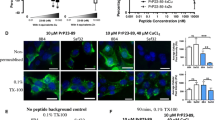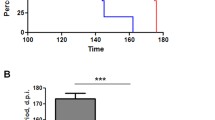Abstract
One of the physiological functions of cellular prion protein (PrPC) is believed to work as a cellular resistance to oxidative stress, in which the octarepeats region within PrP plays an important role. However, the detailed mechanism is less clear. In this study, the expressing plasmids of wild-type PrP (PrP-PG5) and various PrP mutants containing 0 (PrP-PG0), 9 (PrP-PG9) and 12 (PrP-PG12) octarepeats were generated and PrP proteins were expressed both in E. coli and in mammalian cells. Protein aggregation and formation of carbonyl groups were clearly seen in the recombinant PrPs expressed from E. coli after treatment of H2O2. MTT and trypan blue staining assays revealed that the cells expressing the mutated PrPs within octarepeats are less viable than the cells expressing wild-type PrP. Statistically significant high levels of intracellular free radicals and low levels of glutathione peroxidase were observed in the cells transfected with plasmids containing deleted or inserted octarepeats. Remarkably more productions of carbonyl groups were detected in the cells expressing PrPs with deleted and inserted octarepeats after exposing to H2O2. Furthermore, cells expressing wild-type PrP showed stronger resistant activity to the challenge of H2O2 at certain extent than the mutated PrPs and mock. These data provided the evidences that the octarepeats number within PrP is critical for maintaining its activity of antioxidation. Loss of its protective function against oxidative stress may be one of the possible pathways for the mutated PrPs to involve in the pathogenesis of familial Creutzfeldt-Jacob diseases.
Similar content being viewed by others
References
Prusiner S B. Prions. Proc Natl Acad Sci USA, 1998, 95: 13363–13373, 9811807, 10.1073/pnas.95.23.13363, 1:CAS:528:DyaK1cXnsVGhsbY%3D
Prusiner S B, Groth D, Serban A, et al. Ablation of the prion protein (PrP) gene in mice prevents scrapie and facilitates production of anti-PrP antibodies. Proc Natl Acad Sci USA, 1993, 90: 10608–10612, 7902565, 10.1073/pnas.90.22.10608, 1:CAS:528:DyaK2cXnsVGitw%3D%3D
Goldfarb L G, Brown P, McCombie W R, et al. Transmissible familial Creutzfeldt-Jakob disease associated with five, seven, and eight extra octapeptide coding repeats in the PRNP gene. Proc Natl Acad Sci USA, 1991, 88: 10926–10930, 1683708, 10.1073/pnas.88.23.10926, 1:CAS:528:DyaK38XotFCnug%3D%3D
Poulter M, Baker H F, Frith C D, et al. Inherited prion disease with 144 base pair insertion. Genealogical Molecular Studies-Brain, 1992, 115: 675–685
Owen F, Poulter M, Shah T, et al. An in-frame insertion in the prion protein gene in familial Creutzfeldt-Jakob disease. Brain Res Mol Brain Res, 1990, 7: 273–276, 2159587, 10.1016/0169-328X(90)90038-F, 1:CAS:528:DyaK3cXktVWnsrg%3D
Cochran E J, Bennett D A, Cervenáková L, et al. Familial Creutzfeldt-Jakob disease with a five-repeat octapeptide insert mutation. Neurology, 1996, 47: 727–733, 8797471, 1:CAS:528:DyaK28XmtFWisbs%3D
Horiuchi M, Caughey B. Prion protein interconversions and the transmissible spongiform encephalopathies. Structure, 1999, 7: 231–240, 10.1016/S0969-2126(00)80049-0
Griffit J S. Self-replication and scrapie. Nature, 1967, 215(105): 1043–1044, 10.1038/2151043a0
Huang Z, Prusiner S B, Cohen F E. Scrapie prions: a three-dimensional model of an infectious fragment. Fold Des, 1996, 1(1): 13–19, 9079359, 10.1016/S1359-0278(96)00007-7, 1:CAS:528:DyaK28XktlKisbs%3D
Hornshaw M P, McDermott J R, Candy J M, et al. Copper binding to the N-terminal tandem repeat region of mammalian and avian prion protein: Structural studies using synthetic peptides. Biochem Biophys Res Commun, 1995, 214: 621–629, 10.1006/bbrc.1995.1233
Brown D R, Qin K, Herms J W, et al. The cellular prion protein binds copper in vivo. Nature, 1997c, 390: 684–687, 9414160, 10.1038/37733, 1:CAS:528:DyaK1cXpvFKj
Miura T, Hori-I A, Takeuchi H, et al. Metal-dependent alpha-helix formation promoted by the glycine-rich octapeptide region of prion protein. FEBS Lett, 1996, 396(2–3): 248–252, 8914996, 10.1016/0014-5793(96)01104-0, 1:CAS:528:DyaK28Xms1eiurY%3D
Pauly P C, Harris D A. Copper stimulates endocytosis of the prion protein. J Biol Chem, 1998, 273: 33107–33110, 9837873, 10.1074/jbc.273.50.33107, 1:CAS:528:DyaK1MXjtQ%3D%3D
Brown D R, Besinger A. Prion protein expression and superoxide dismutase activity. Biochem J, 1998, 334: 423–429, 9716501, 1:CAS:528:DyaK1cXmtFOlsb0%3D
Markesbery W R. Oxidative stress hypothesis in Alzheimer’s disease. Free Radic Biol Med, 1997, 23: 134–137, 9165306, 10.1016/S0891-5849(96)00629-6, 1:CAS:528:DyaK2sXjtlaqs7o%3D
Hensley K, Hall N, Subramaniam R, et al. Brain regional correspondence between Alzheimer’s disease histopathology and biomarkers of protein oxidation. J Neurochem, 1995, 65: 2146–2156, 7595501, 1:CAS:528:DyaK2MXovFGmtLY%3D, 10.1046/j.1471-4159.1995.65052146.x
Lee D W, Sohn H O, Lim H B, et al, Alteration of free radical metabolism in the brain of mice infected with scrapie agent. Free Radic Res, 1999, 30: 499–507, 10400462, 10.1080/10715769900300541, 1:CAS:528:DyaK1MXktFWltLo%3D
Wong B S, Chen S G, Monica C, et al. Aberrant metal binding by prion protein in human prion disease. J Neurochem, 2001, 78: 1400–1408, 11579148, 10.1046/j.1471-4159.2001.00522.x, 1:CAS:528:DC%2BD3MXnt12isL4%3D
Gao J M, Gao C, Han J, et al, Dynamic analyses of PrP and PrPSc in brain tissues of golden hamsters infected with scrapie strain 263K revealed various PrP forms. Biomed Environ Sci, 2004, 17: 8–20, 15202859
Gao C, Lei Y J, Han J, et al, Recombinant neural protein PrP can bind with both recombinant and native apolipoprotein E in vitro. Acta Biochim Biophys Sin, 2006, 38: 593–601, 16953297, 10.1111/j.1745-7270.2006.00209.x, 1:CAS:528:DC%2BD28XhtFSjs7jI
Wang X F, Guo Y J, Zhang B Y, et al, Creutzfeldt-Jakob disease in a Chinese patient with a novel seven extra-repeat insertion in PRNP. J Neurol Neurosur Ps, 2007, 78(2): 201–203, 10.1136/jnnp.2006.09433, 1:STN:280:DC%2BD2s%2Fjt1OlsA%3D%3D
Chen L, Yang Y, Han J, et al. Removal of the glycosylation of prion protein provoke apoptosis in SF126. J Biochem Mol Biol, 2007, 30: 662–629
Han J, Zhang J, Yao H L, et al, Study on interaction between microtubule associated protein tau and prion protein. Sci China Ser C-Life Sci, 2006, 49: 473–479, 10.1007/s11427-006-2019-9, 1:CAS:528:DC%2BD2sXktlWktA%3D%3D
Brown D R, Schulz-Schaeffer W J, Schmidt B, et al. Prion protein-deficient cells show altered response to oxidative stress due to decreased SOD-1 activity. Exp Neurol, 1997, 146(1): 104–112, 9225743, 10.1006/exnr.1997.6505, 1:CAS:528:DyaK2sXkslOit7o%3D
Kuwahara C, Takeuchi A M, Nishimura T, et al. Prions prevent neuronal cell-line death. Nature, 1999, 400(6741): 225–226, 10421360, 10.1038/22241, 1:CAS:528:DyaK1MXkvFWmsbk%3D
White A R, Collins S J, Maher F, et al. Prion protein-deficient neurons reveal lower glutathione reductase activity and increased susceptibility to hydrogen peroxide toxicity. Am J Pathol, 1999, 155: 1723–1730, 10550328, 1:CAS:528:DyaK1MXnvVKisb4%3D
Owen F, Poulter M, Lofthouse R, et al. Insertion in prion protein gene in familial Creutzfeldt-Jakob disease. Lancet, 1989, 1(8628): 51–52, 2563037, 10.1016/S0140-6736(89)91713-3, 1:STN:280:DyaL1M%2Fps1Whtg%3D%3D
Yin S, Yu S, Li C, et al. Prion proteins with insertion mutations have altered N-terminal conformation and increased ligand binding activity and are more susceptible to oxidative attack. J Biol Chem, 2006, 281(16): 10698–10705, 16478730, 10.1074/jbc.M511819200, 1:CAS:528:DC%2BD28XjsFSqtbs%3D
Requena J R, Groth D, Legname G, et al, Copper-catalyzed oxidation of the recombinant SHa(29-231) prion protein. Proc Natl Acad Sci USA, 2001, 98(13): 7170–7175, 11404462, 10.1073/pnas.121190898, 1:CAS:528:DC%2BD3MXkslWmt7w%3D
Freedman J H, Ciriolo M R, Peisach J. The role of glutathionein copper metabolism and toxicity. J Biol Chem, 1989, 264: 5598–5605, 2564391, 1:CAS:528:DyaL1MXhvVOnur0%3D
Hyslop P A, Zhang Z, Pearson D V, et al, Measurement of striatal H2O2 by microdialysis following global forebrain ischemia and reperfusion in the rat: Correlation with the cytotoxic potential of H2O2in vitro. Brain Res, 1995, 671(2): 181–186, 7743206, 10.1016/0006-8993(94)01291-O, 1:CAS:528:DyaK2MXktFelt74%3D
Watt D R, Taylor A, Gillott A, et al. Reactive oxygen species-mediated cleavage of the prion protein in the cellular rresponse to oxidative stress. J Biol Chem, 2005, 280: 35914–35921, 16120605, 10.1074/jbc.M507327200, 1:CAS:528:DC%2BD2MXhtFCjsbfL
Author information
Authors and Affiliations
Corresponding author
Additional information
Supported by the National Science and Technology Task Force Project (Grant No. 2006BAD06A13-2), National Basic Research Program (973 Program) of China (Grant No. 2007CB310505) and National Natural Science Foundation of China (Grant Nos. 30571672, 30500018 and 30771914)
Rights and permissions
About this article
Cite this article
An, R., Dong, C., Lei, Y. et al. PrP mutants with different numbers of octarepeat sequences are more susceptible to the oxidative stress. SCI CHINA SER C 51, 630–639 (2008). https://doi.org/10.1007/s11427-008-0062-4
Received:
Accepted:
Published:
Issue Date:
DOI: https://doi.org/10.1007/s11427-008-0062-4




